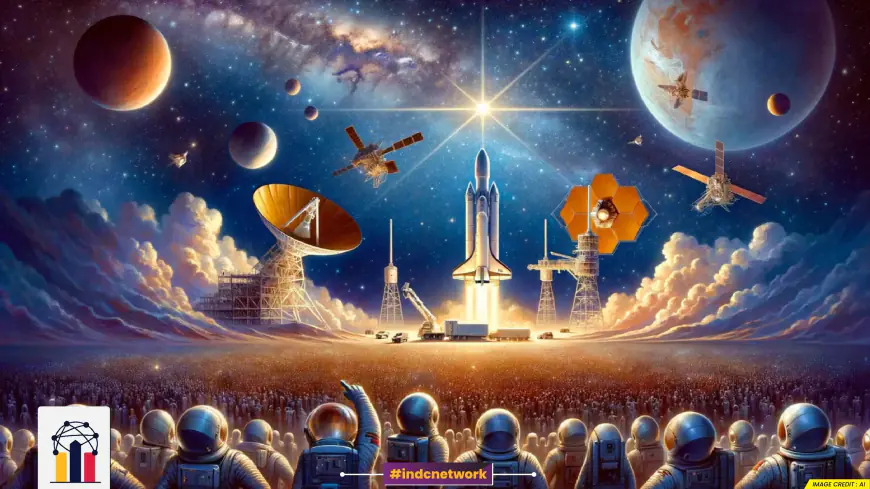The Future of Space Travel: Exploring New Frontiers, Technologies, and Missions Beyond Earth
The future of space travel is poised for revolutionary breakthroughs, driven by advancements in technology, the involvement of private companies, and international collaborations. From reusable rockets and space tourism to long-term missions on the Moon and Mars, space exploration is rapidly evolving. This article delves into the next phase of space travel, focusing on innovations like SpaceX's Starship, NASA's Artemis program, Mars colonization, and beyond. We also explore emerging technologies such as space mining, nuclear propulsion, and the potential for interstellar travel, painting a picture of what the future of humanity in space might look like.

INDC Network : Science : The Future of Space Travel: Exploring New Frontiers, Technologies, and Missions Beyond Earth
The dream of space travel has fascinated humanity for centuries, and today, we are closer than ever to turning those dreams into reality. With technological advancements accelerating at an unprecedented pace and private companies transforming the landscape of space exploration, the future of space travel is on the verge of monumental breakthroughs. Governments and corporations are no longer just aiming for low Earth orbit; they are setting their sights on the Moon, Mars, asteroids, and even deep space exploration.
As we look ahead, we find ourselves on the cusp of a new era where the boundaries between science fiction and reality are increasingly blurred. This article takes an in-depth look at the future of space travel, covering innovations in technology, upcoming missions, space tourism, and the broader implications of human exploration beyond Earth.
Space Travel 2.0: The Role of Private Companies
The landscape of space travel has shifted dramatically in recent years, primarily due to the rise of private space companies such as SpaceX, Blue Origin, and Virgin Galactic. These companies have introduced a new level of competition and innovation in the space industry, driving down costs and making space travel more accessible.
SpaceX, founded by Elon Musk, has been a trailblazer in developing reusable rocket technology. The company’s Falcon 9 rocket has already revolutionized space travel by landing its first stage booster back on Earth after completing missions. The next step is SpaceX's Starship, a fully reusable spacecraft designed for long-duration missions to the Moon, Mars, and beyond. Starship is set to play a pivotal role in NASA’s Artemis program and could be the vessel that first takes humans to Mars.
Blue Origin, founded by Amazon's Jeff Bezos, is also developing reusable rocket systems like the New Shepard and New Glenn, with a focus on space tourism and lunar missions. The company’s goal is to reduce the cost of space travel and ultimately create infrastructure for millions of people to live and work in space.
Virgin Galactic, led by Richard Branson, is aiming to make space tourism a reality for non-professional astronauts. With its suborbital flights, Virgin Galactic plans to offer civilians the chance to experience weightlessness and witness the curvature of the Earth from space.
As these companies continue to innovate, the barriers to space access are steadily being lowered. The involvement of private entities is creating a more dynamic and sustainable ecosystem for space exploration, one that will likely accelerate humanity's reach into the solar system.
Reusable Rockets: Making Space Travel More Affordable
At the heart of these private companies' efforts is the development of reusable rockets. For decades, space travel has been prohibitively expensive due to the single-use nature of rocket stages. Every rocket launch required a brand-new, multi-million-dollar rocket, making space missions extremely costly. The advent of reusable rockets has changed that equation.
SpaceX’s Falcon 9 and Falcon Heavy rockets have demonstrated the feasibility of landing rocket boosters back on Earth for refurbishment and reuse. This drastically reduces the cost per launch, potentially making space travel more akin to commercial aviation in terms of cost-effectiveness.
Starship, currently under development by SpaceX, is designed to be a fully reusable spacecraft, including its upper stage. Once operational, Starship could reduce the cost of launching cargo and humans into space to a fraction of what it is today. This would open up new opportunities for both governmental and commercial space exploration.
In the future, we can expect reusable rockets to become the standard, enabling more frequent missions to the Moon, Mars, and beyond. This innovation will also make space tourism more accessible, allowing civilians to experience space without the high price tag that currently exists.
The Artemis Program: A New Era of Moon Exploration
NASA's Artemis program is a cornerstone of the future of space travel. Named after the twin sister of Apollo in Greek mythology, Artemis aims to return humans to the Moon by 2025 and establish a sustainable presence there by the end of the decade. This will be the first time humans have set foot on the lunar surface since Apollo 17 in 1972.
The Artemis I mission, an uncrewed test flight of NASA’s Space Launch System (SLS) and Orion spacecraft, marked the beginning of this new lunar exploration era. The upcoming Artemis II will take astronauts around the Moon, and Artemis III will land the first woman and the next man on the lunar surface, targeting the Moon's South Pole, where there is potential access to water ice.
The long-term vision of Artemis goes beyond simply visiting the Moon. NASA aims to build a lunar base, called the Lunar Gateway, which will serve as a staging ground for future missions, including those to Mars. The Moon will also be a testing ground for technologies and systems that will support deep space missions.
This renewed focus on the Moon is critical for the future of space travel. The lunar surface offers valuable resources such as water, which can be split into hydrogen and oxygen for rocket fuel. The Moon’s low gravity makes it an ideal launching point for missions to deeper parts of the solar system, reducing the cost and complexity of interplanetary travel.
Mars: Humanity’s Next Great Adventure
While the Artemis program focuses on the Moon, the ultimate goal for many space agencies and private companies is Mars. Mars has long fascinated scientists due to its potential to support life, its relatively similar day-night cycle to Earth, and the presence of water ice. The red planet is seen as the next logical step in human space exploration.
SpaceX's Starship is designed with Mars in mind, and Elon Musk has repeatedly stated that his goal is to establish a self-sustaining human colony on Mars. The challenges of Mars colonization are immense, ranging from the planet’s thin atmosphere and freezing temperatures to the psychological and physical effects of long-duration space travel.
NASA’s Perseverance Rover is currently exploring the Martian surface, collecting data that will inform future human missions. Its primary objective is to search for signs of ancient microbial life and study the planet's geology. Additionally, China’s Tianwen-1 mission is contributing to humanity’s growing knowledge of Mars.
The next decade could see the first human missions to Mars, with NASA and SpaceX working on parallel paths. These missions will test our ability to live and work on another planet for extended periods, with the ultimate goal of establishing permanent settlements. A successful human mission to Mars would be the most significant achievement in space exploration since the Apollo Moon landings.
Emerging Technologies: Nuclear Propulsion, Space Mining, and Space Habitats
The future of space travel will rely heavily on the development of new technologies that can overcome the challenges of deep space exploration. Three areas of innovation stand out: nuclear propulsion, space mining, and space habitats.
-
Nuclear Propulsion: Traditional chemical rockets, while effective for reaching low Earth orbit, are inefficient for deep space missions due to their limited speed and fuel capacity. Nuclear propulsion systems, which use nuclear reactors to generate thrust, could revolutionize space travel by drastically reducing the time it takes to travel between planets. For example, a mission to Mars using nuclear propulsion could take just three to four months instead of the current seven to nine months with chemical rockets. NASA and private companies like Nuclear Thermal Propulsion are actively researching these technologies.
-
Space Mining: As humanity ventures further into space, the need for resources will grow. Space mining, the extraction of valuable materials from asteroids and other celestial bodies, could provide the raw materials needed for building habitats, spacecraft, and fuel. Asteroids contain vast amounts of precious metals, water, and other resources that could support space-based industries and reduce the reliance on Earth’s limited supplies. Companies like Planetary Resources and Deep Space Industries are already developing technology to mine asteroids in the future.
-
Space Habitats: Long-duration space missions require more than just rockets; they need habitats where astronauts can live and work for extended periods. Advances in space habitats, such as inflatable space stations and 3D-printed structures, are being developed to support missions to the Moon, Mars, and beyond. NASA is testing inflatable habitats, like the Bigelow Expandable Activity Module (BEAM), on the ISS, which could pave the way for similar structures on the Moon or Mars. These habitats would provide radiation shielding, life support systems, and comfortable living conditions for astronauts on long-term missions.
Space Tourism: The Next Frontier for Civilians
As space travel becomes more affordable and accessible, space tourism is poised to become a reality for non-professional astronauts. Companies like SpaceX, Blue Origin, and Virgin Galactic are leading the charge in making space tourism available to the public.
Virgin Galactic has already sold hundreds of tickets for suborbital flights aboard its SpaceShipTwo vehicle. These flights will allow passengers to experience a few minutes of weightlessness and see the curvature of the Earth from the edge of space.
Blue Origin's New Shepard vehicle is also designed for suborbital tourism, offering a similar experience. The company envisions a future where space tourism becomes a regular occurrence, and civilians can travel to space as easily as booking a flight on an airplane.
While these early space tourism ventures will be short and expensive, the long-term goal is to offer more extended stays in space, potentially on orbiting space hotels or even lunar resorts. As reusable rocket technology continues to improve and the costs of launching people into space decrease, space tourism could become a multi-billion-dollar industry.
The Challenges Ahead: Sustainability and Ethical Considerations
While the future of space travel is full of promise, it also comes with significant challenges. One of the most pressing issues is the sustainability of space exploration. As more satellites, spacecraft, and space debris accumulate in Earth's orbit, the risk of collisions and the creation of hazardous debris fields increases. Companies and space agencies must develop strategies to mitigate space debris and ensure that space remains a safe environment for future exploration.
Another challenge is the ethical considerations of space exploration, particularly as we begin to explore other planets and celestial bodies. Questions arise about how we should interact with potential extraterrestrial life forms or ecosystems, as well as who has the right to exploit resources on the Moon, Mars, or asteroids. International laws and treaties will need to evolve to address these emerging issues.
Conclusion: The Infinite Possibilities of Space Travel : The future of space travel is nothing short of extraordinary. From reusable rockets and space tourism to missions that aim to establish human presence on the Moon and Mars, space exploration is entering a new era of innovation and discovery. The rapid advancements in technology, the involvement of private companies, and international collaborations are accelerating humanity’s journey into the cosmos.
As we stand on the brink of becoming an interplanetary species, the possibilities for space travel seem infinite. The next few decades will likely see groundbreaking achievements that will reshape our understanding of the universe and our place within it. With the right technological innovations and ethical frameworks in place, humanity is poised to explore the stars and unlock the mysteries of the cosmos, charting a new path for future generations.
What's Your Reaction?













































































































































































